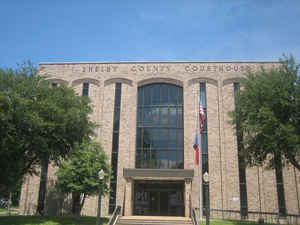Texas Counties
Texas is divided into two hundred and fifty-four counties, more than any other state. Texas was originally divided into municipalities, a unit of local government under Spanish and Mexican rule. When the Republic of Texas gained its independence in 1836, there were 23 municipalities, which became the original Texas counties. Many of these would later be divided into new counties. The most recent county to be created was Kenedy County in 1921. The most recent county to be organized was Loving County in 1931Shelby County, Texas
Shelby County Education, Geography, and History

Shelby County is a county located in the far eastern portion of the state of Texas. Based on the 2010 census, its population was 25,448. Its county seat is Center. The county was created in 1835 as a municipality of Mexico and organized as a county in 1837. It is named for Isaac Shelby, a soldier in the American Revolution who became the first governor of Kentucky.
Etymology - Origin of Shelby County Name
Isaac Shelby, a Revolutionary War soldier from Tennessee and the first Governor of Kentucky
Demographics:
County QuickFacts: CensusBureau Quick Facts
Shelby County History
Shelby County was formed in 1837. It was named for Isaac Shelby, a soldier from Tennessee during the American Revolution, and first Governor of Kentucky. Its county seat is Center.
Handbook of Texas Online
Shelby County was first organized under the Mexican government as Tenehaw Municipality;
Nashville, founded in 1824, was the most important town. In 1836 the Congress of the Republic of Texas
established Shelby County, named for Isaac Shelby, hero of the American Revolution and governor of Kentucky. The
name of the town Nashville was changed to Shelbyville, and Shelbyville became the county seat, which it remained
until 1866, when the county seat was moved to Center. Since that time Center has remained the county seat. The
courthouse in Center, along with all county records, was destroyed by fire in 1882. A new courthouse, modeled on an
Irish castle, was designed by the architect John Joseph Emmett Gibson, an Irish immigrant. It was completed in 1885
and was recognized in the National Register of Historic Places in 1971. The courthouse still housed the county
government in 1984. In 1840 disputes over land titles and fraudulent land transactions led to the opposition of two
factions, the Regulators and the Moderators, and a series of armed conflicts that came to be known as the
Regulator-Moderator War. Before the conflict was finally resolved in 1844, a
number of the individuals involved were killed or tried and hanged, and the economy of Shelby County seems to have
been devastated. The San Augustine Red-Lander said in a comment on the
war that "land is now ten cents an acre in Shelby County where formerly it was valued at more than twenty times that
sum; and the tide of emigration has completely turned from that country which is shunned by emigrants as another
sodom." The effects of the war on the county's economy and growth do not appear to have been permanent. By 1847 the
county had a population of 3,318, which was only marginally lower than San Augustine County to the south and Panola
County to the north. Between 1847 and 1860 Shelby County continued to grow to 4,239 and 5,362, recorded in 1850 and
1860, respectively. Most of the Anglos who settled the county came from other southern states, and they brought with
them the institution of slavery. Although slaveholding was restricted to a small
minority of the Anglo population, slavery was an integral part of the county's economic and social systems. In fact,
between 1847 and 1860 the number of slaves in the county grew at a faster rate than did the free population. The 763
slaves present in 1847 constituted a little under 23 percent of the total population, and the 1,476 slaves present
in 1860 constituted just less than 28 percent of the total population. During the antebellum period the county was,
for the most part, rural and agricultural, with most of the county's residents living on farms. The largest crop of
any kind and the most important food crop was corn. County farmers produced 99,518 bushels in 1850. Farmers also
grew 9,805 bushels of oats. The largest cash crop was cotton, but farmers produced just 790 bales in 1850. Livestock
was also important to the county's economy. The more than 20,000 hogs in the county were a major food source, as
were the 10,000 cattle. During the 1850s arable production expanded much more rapidly than did the population of the
county. By 1860 the corn crop had risen by 70 percent, increasing to 167,475 bushels, while the cotton crop was a
little more than five times larger than the 1850 crop with production totalling 4,052 bales. Livestock production
did not change so dramatically. The number of hogs and cattle in the county declined slightly, but sheep production
grew from an 1850 total of 1,296 and 1,770 pounds of wool to 2,794 sheep and 7,408 pounds of wool by 1860 More at
Cecil Harper, Jr., "SHELBY COUNTY," Handbook of Texas Online (http://www.tshaonline.org/handbook/online/articles/hcs09),
accessed January 24, 2016. Uploaded on June 15, 2010. Published by the Texas State Historical Association.
Geography: Land and Water
As reported by the Census Bureau, the county has a total area of 835 square miles (2,161 km2), of which, 794 square miles (2,057 km2) of it is land and 40 square miles (105 km2) of it (4.84%) is water.
Neighboring Counties
Bordering counties are as follows:
- Panola County (north)
- De Soto Parish, Louisiana (northeast)
- Sabine Parish, Louisiana (east)
- Sabine County (south)
- San Augustine County (south)
- Nacogdoches County (southwest)
- Rusk County (northwest)
Education
The following school districts serve Shelby County:
Center ISD
Excelsior ISD
Joaquin ISD (small portion in Panola County)
San Augustine ISD (mostly in San Augustine County)
Shelbyville ISD (small portion in Sabine County)
Tenaha ISD (small portion in Panola County)
Timpson ISD







